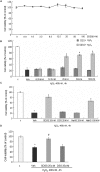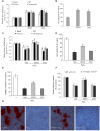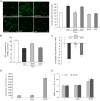The New Synthetic H2S-Releasing SDSS Protects MC3T3-E1 Osteoblasts against H2O2-Induced Apoptosis by Suppressing Oxidative Stress, Inhibiting MAPKs, and Activating the PI3K/Akt Pathway
- PMID: 28163684
- PMCID: PMC5247634
- DOI: 10.3389/fphar.2017.00007
The New Synthetic H2S-Releasing SDSS Protects MC3T3-E1 Osteoblasts against H2O2-Induced Apoptosis by Suppressing Oxidative Stress, Inhibiting MAPKs, and Activating the PI3K/Akt Pathway
Abstract
Reactive oxygen species (ROS) are important in osteoporosis development. Oxidative stress induces apoptosis of osteoblasts and arrest of their differentiation. Both Danshensu (DSS) and hydrogen sulfide (H2S) produce significant antioxidant effect in various systems. In this study, we synthesized SDSS, a novel H2S-releasing compound derived from DSS, and studied its antioxidant effect in an H2O2-induced MC3T3-E1 osteoblastic cell injury model. We first characterized the H2S releasing property of SDSS in both in vivo and in vitro models. HPLC chromatogram showed that intravenous injection of SDSS in adult rats released ADT-OH, a well proved H2S sustained-release moiety, within several minutes in the rat plasma. Using an H2S selective fluorescent probe, we further confirmed that SDSS released H2S in MC3T3-E1 osteoblastic cells. Biological studies revealed that SDSS had no significant toxic effect but produced protective effects against H2O2-induced MC3T3-E1 cell apoptosis. SDSS also reversed the arrest of cell differentiation caused by H2O2 treatment. This was caused by the stimulatory effect of SDSS on bone sialoprotein, runt-related transcription factor 2, collagen expression, alkaline phosphatase activity, and bone nodule formation. Further studies revealed that SDSS reversed the reduced superoxide dismutase activity and glutathione content, and the increased ROS production in H2O2 treated cells. In addition, SDSS significantly attenuated H2O2-induced activation of p38-, ERK1/2-, and JNK-MAPKs. SDSS also stimulated phosphatidylinositol 3-kinase/Akt signaling pathway. Blockade of this pathway attenuated the cytoprotective effect of SDSS. In conclusion, SDSS protects MC3T3-E1 cells against H2O2-induced apoptosis by suppressing oxidative stress, inhibiting MAPKs, and activating the phosphatidylinositol 3-kinase/Akt pathway.
Keywords: MAPK signaling; PI3K/AKT; hydrogen sulfide donating drugs; osteoblast; reactive oxygen species.
Figures






Similar articles
-
Hydrogen sulfide protects MC3T3-E1 osteoblastic cells against H2O2-induced oxidative damage-implications for the treatment of osteoporosis.Free Radic Biol Med. 2011 May 15;50(10):1314-23. doi: 10.1016/j.freeradbiomed.2011.02.016. Epub 2011 Feb 24. Free Radic Biol Med. 2011. PMID: 21354302
-
MiR-214 protects MC3T3-E1 osteoblasts against H2O2-induced apoptosis by suppressing oxidative stress and targeting ATF4.Eur Rev Med Pharmacol Sci. 2017 Nov;21(21):4762-4770. Eur Rev Med Pharmacol Sci. 2017. PMID: 29164589
-
Phosphocreatine Promotes Osteoblastic Activities in H2O2-Induced MC3T3-E1 Cells by Regulating SIRT1/FOXO1/PGC-1α Signaling Pathway.Curr Pharm Biotechnol. 2021;22(5):609-621. doi: 10.2174/1389201021999201116160247. Curr Pharm Biotechnol. 2021. PMID: 33198615
-
GYY4137 stimulates osteoblastic cell proliferation and differentiation via an ERK1/2-dependent anti-oxidant mechanism.Am J Transl Res. 2017 Mar 15;9(3):1183-1192. eCollection 2017. Am J Transl Res. 2017. PMID: 28386344 Free PMC article.
-
The potential role of hydrogen sulfide in cancer cell apoptosis.Cell Death Discov. 2024 Mar 6;10(1):114. doi: 10.1038/s41420-024-01868-w. Cell Death Discov. 2024. PMID: 38448410 Free PMC article. Review.
Cited by
-
Curculigoside Protects against Excess-Iron-Induced Bone Loss by Attenuating Akt-FoxO1-Dependent Oxidative Damage to Mice and Osteoblastic MC3T3-E1 Cells.Oxid Med Cell Longev. 2019 Dec 17;2019:9281481. doi: 10.1155/2019/9281481. eCollection 2019. Oxid Med Cell Longev. 2019. PMID: 31949885 Free PMC article.
-
Alveolar epithelial cell dysfunction and epithelial-mesenchymal transition in pulmonary fibrosis pathogenesis.Front Mol Biosci. 2025 Apr 24;12:1564176. doi: 10.3389/fmolb.2025.1564176. eCollection 2025. Front Mol Biosci. 2025. PMID: 40343260 Free PMC article. Review.
-
H2S Donor and Bone Metabolism.Front Pharmacol. 2021 Jul 22;12:661601. doi: 10.3389/fphar.2021.661601. eCollection 2021. Front Pharmacol. 2021. PMID: 34366840 Free PMC article. Review.
-
International Union of Basic and Clinical Pharmacology. CII: Pharmacological Modulation of H2S Levels: H2S Donors and H2S Biosynthesis Inhibitors.Pharmacol Rev. 2017 Oct;69(4):497-564. doi: 10.1124/pr.117.014050. Pharmacol Rev. 2017. PMID: 28978633 Free PMC article. Review.
-
Inductive Materials for Regenerative Engineering.J Dent Res. 2021 Sep;100(10):1011-1019. doi: 10.1177/00220345211010436. Epub 2021 Apr 27. J Dent Res. 2021. PMID: 33906507 Free PMC article. Review.
References
-
- Banerjee Mustafi S., Chakraborty P. K., Dey R. S., Raha S. (2009). Heat stress upregulates chaperone heat shock protein 70 and antioxidant manganese superoxide dismutase through reactive oxygen species (ROS), p38MAPK, and Akt. Cell Stress Chaperones 14 579–589. 10.1007/s12192-009-0109-x - DOI - PMC - PubMed
LinkOut - more resources
Full Text Sources
Other Literature Sources
Research Materials
Miscellaneous

